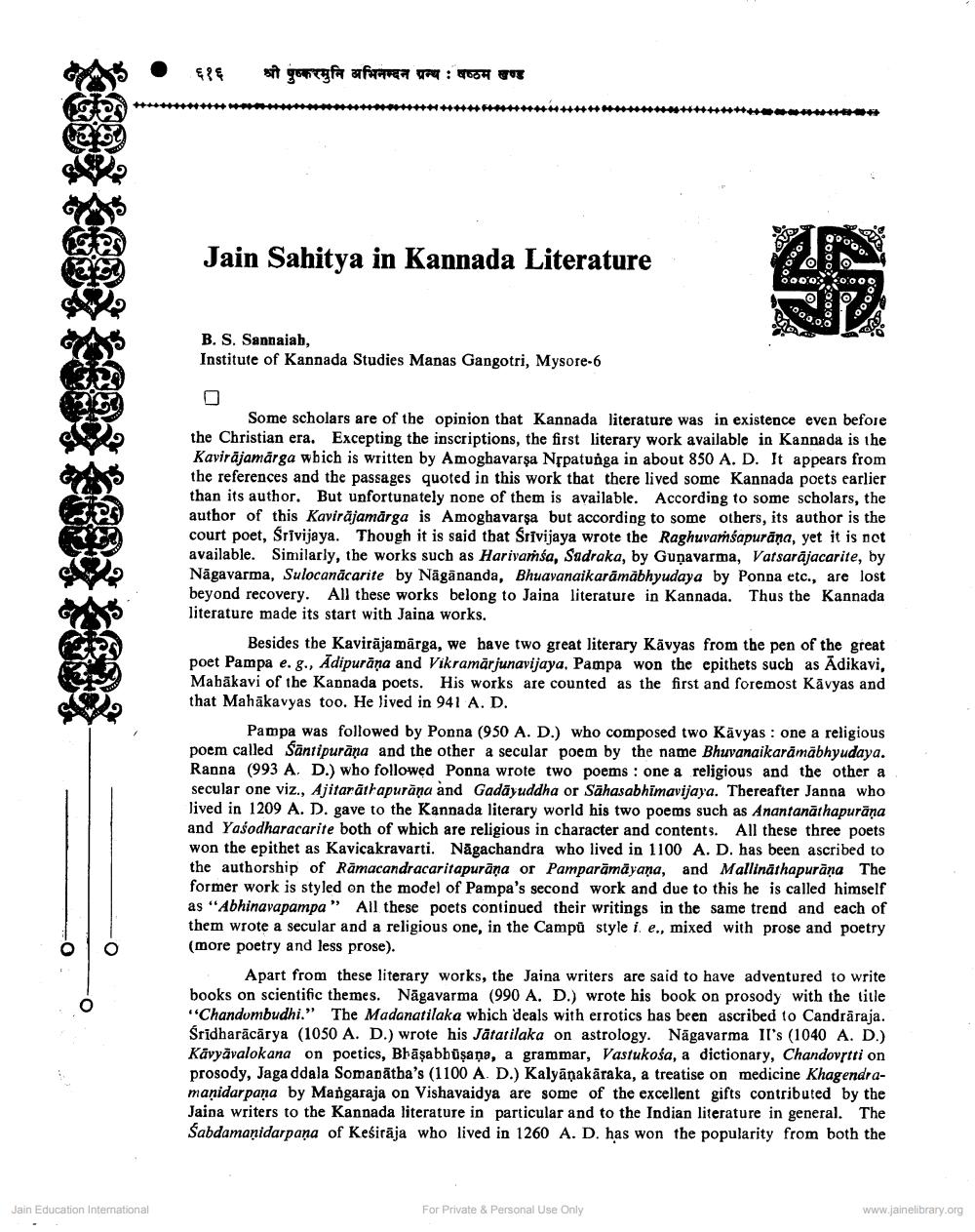________________
-O
O
O
Jain Education International
६१६
sit yoकरमुनि अभिनन्दन ग्रन्थ : षष्ठम खण्ड
45
Some scholars are of the opinion that Kannada literature was in existence even before the Christian era. Excepting the inscriptions, the first literary work available in Kannada is the Kavirajamärga which is written by Amoghavarsa Nrpatunga in about 850 A. D. It appears from the references and the passages quoted in this work that there lived some Kannada poets earlier than its author. But unfortunately none of them is available. According to some scholars, the author of this Kavirajamārga is Amoghavarşa but according to some others, its author is the court poet, Śrīvijaya. Though it is said that Śrīvijaya wrote the Raghuvamsapuraṇa, yet it is not available. Similarly, the works such as Harivamsa, Sadraka, by Gunavarma, Vatsarajacarite, by Nagavarma, Sulocanacarite by Nagananda, Bhuavanaikarāmäbhyudaya by Ponna etc., are lost beyond recovery. All these works belong to Jaina literature in Kannada. Thus the Kannada literature made its start with Jaina works.
Jain Sahitya in Kannada Literature
B. S. Sannaiah,
Institute of Kannada Studies Manas Gangotri, Mysore-6
Besides the Kavirajamarga, we have two great literary Kavyas from the pen of the great poet Pampa e. g., Adipurāna and Vikramārjunavijaya, Pampa won the epithets such as Adikavi, Mahakavi of the Kannada poets. His works are counted as the first and foremost Kavyas and that Mahakavyas too. He lived in 941 A. D.
Pampa was followed by Ponna (950 A. D.) who composed two Kavyas: one a religious poem called Santipurana and the other a secular poem by the name Bhuvanaikaramābhyudaya. Ranna (993 A. D.) who followed Ponna wrote two poems: one a religious and the other a secular one viz., Ajitarathapuraṇa and Gadayuddha or Sahasabhimavijaya. Thereafter Janna who lived in 1209 A. D. gave to the Kannada literary world his two poems such as Anantanathapurāṇa and Yasodharacarite both of which are religious in character and contents. All these three poets won the epithet as Kavicakravarti. Nāgachandra who lived in 1100 A. D. has been ascribed to the authorship of Ramacandracaritapurāna or Pamparāmāyaṇa, and Mallinathapurana The former work is styled on the model of Pampa's second work and due to this he is called himself as "Abhinavapampa" All these poets continued their writings in the same trend and each of them wrote a secular and a religious one, in the Campu style i. e., mixed with prose and poetry (more poetry and less prose).
Apart from these literary works, the Jaina writers are said to have adventured to write books on scientific themes. Nagavarma (990 A. D.) wrote his book on prosody with the title "Chandombudhi." The Madanatilaka which deals with errotics has been ascribed to Candraraja. Śrīdharācārya (1050 A. D.) wrote his Jätatilaka on astrology. Nagavarma II's (1040 A. D.) Kävyävalokana on poetics, Bhāṣabbüṣaṇa, a grammar, Vastukosa, a dictionary, Chandovrtti on prosody, Jaga ddala Somanatha's (1100 A. D.) Kalyāṇakaraka, a treatise on medicine Khagendramanidarpana by Mangaraja on Vishavaidya are some of the excellent gifts contributed by the Jaina writers to the Kannada literature in particular and to the Indian literature in general. The Sabdamaṇidarpana of Keśiraja who lived in 1260 A. D. has won the popularity from both the
For Private & Personal Use Only
www.jainelibrary.org




